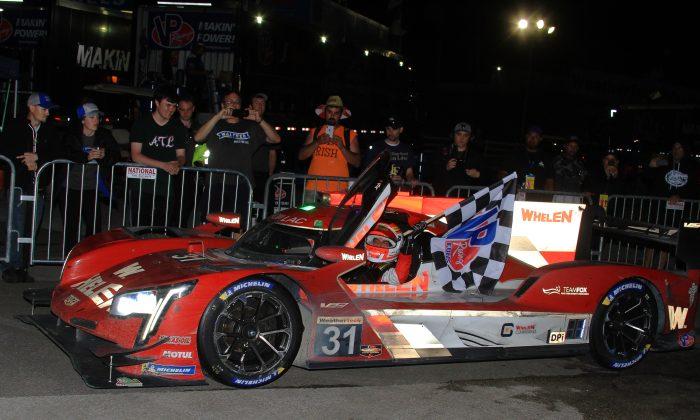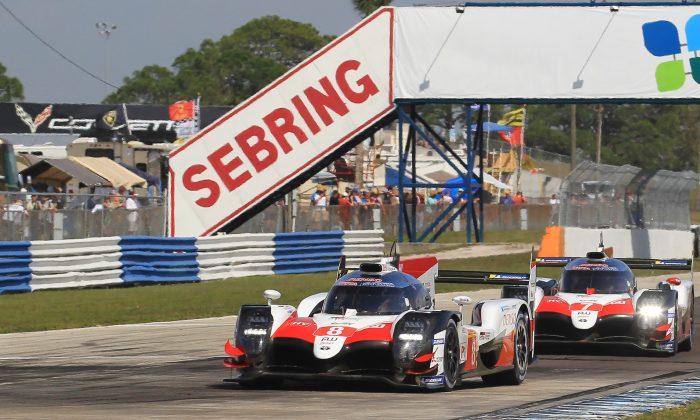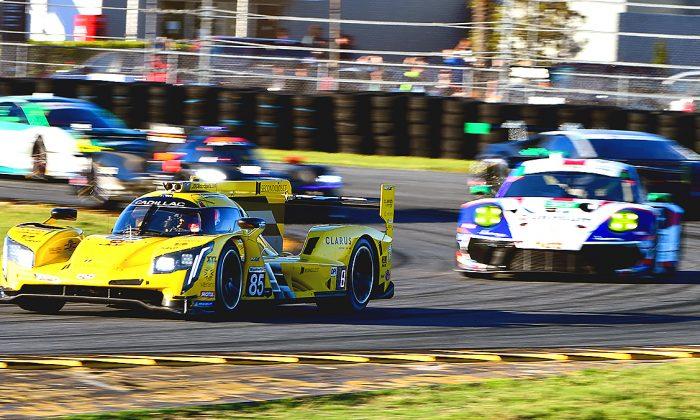DAYTONA, Fla.—Any worries fans might have had that the Tudor United SportCar Championship management wouldn’t properly balance the performance of Daytona Prototypes and P2s for the 2015 season-opening Rolex 24 at Daytona should feel reassured by the performance AJ Allmendinger turned in Saturday afternoon.
The IndyCar and NASCAR star jumped into the brand new Michael Shank Racing Ligier PS2-Honda and, in the closing minutes of the third Roar Before the 24 test session, dethroned the 2014 champion 5 Action Express Racing Coyote-Corvette as the quickest car on track in the session.
Allmendinger wheeled the Ligier around Daytona’s 3.56-mile track in 1:39.418 at 128.910 mph, .025 seconds quicker than the 1.39.445 turned in by Sebastien Bourdais in the AXR car. This result came on the heels of a luchtime press conference where Allmendinger and the other Shank drivers expressed how much they liked the new machine.

The margin might seem minuscule, particularly since neither car matched the lap of 1.39.181 turned in by Jordan Taylor in the #10 WTR Dallara-Corvette in the morning session. The significance, however, will not be lost on long-term fans of the sport.
The biggest problem facing North American sports car racing, and its two top-tier pro series in the 21st century, has been the difference between prototype classes, with the American Le mans Series using modified ACO (the Le Mans people) specifications while the Rolex Sportscar Series used its proprietary Daytona Prototype regulations.
The ALMS cars were almost exactly the same as which raced at Le Mans, exhibiting the latest construction and aerodynamic developments, and thus changing every year or two. The cars were fast and fragile; they were designed to go fast, not bang and bash. Repairs could be costly since carbon-fiber monocoques can’t be bent back into shape with a hammer and torch.

The DPs were sort of pointy-nosed NASCAR cars, with partial steel tube chassis containing big V8s. The aero, like the chassis, was a little primitive. The cars weren’t as fast but were fun to drive and tough as nails, well suited to the more physical racing style the series allowed. Also, they didn’t change much from year to year, making them cheaper to own and operate.
Merging these two different chassis types, each designed for completely different jobs, seemed impossible—it was unquestionably the hardest job facing the management of the new Tudor series.
Neither fans nor teams were very happy with the Balance of Performance adjustments made in 2014, and the situation at the Rolex 24 was considered one of the worst, with the P2s completely unable to compete with the DPs—the extra downforce was a liability on the banking, and the DPs greater power erased any advantage the P2s had in the infield.
It looks like the 2015 Rolex 24 might be a little more even.
The latest crop of P2s, including the Ligiers of Krohn Racing and MSR, and the HPD run by Extreme Speed Motorsports, have the potential to be slipperier on the banking, making better use of their power at the cost of a little efficiency in the infield. it is possible that the 2015 Balance of Performance—at least at Daytona—might actually make for a fair race.
Or not. Last year the Oak Racing Morgan-Nissan, the progenitor of the new Ligier, was also quickest in one Roar session—but had no chance during the race.
Cause for hope, at least.

BMW Finds Some Pace
Another unexpected outcome of the Saturday afternoon session at the Roar was the pace of the Team RLL BMWs, which finished first and third in the GTLM class. The BMWs had been back of the pack in the morning session, behind Aston Martin, Corvette, Ferrari, and Porsche.
That all changed in the afternoon session as Dirk Werner turned a lap of 1:45.00 at 122.057 mph in the #25 Z4 GTE, besting Patrick Pilet in the #911 factory Porsche by .018 seconds. John Edwards brought the #24 BMW around in 1:45.106 at 121.934.
The #98 Aston martin Racing V8 Vantage, which had lead the prior three sessions, ended up eighth in class.
Times were slower in general in the afternoon session, likely due in part to the warming temperatures.
Colin Braun in the #54 Core Autosport Oreca was quickest in Prototype Challenge in both Saturday sessions.
Kuba Giermaziak in the #81 GB Autosport Porsche 911 GT America was quickest GT Daytona car in the morning session. Christian Engelhart in the Konrad Motorsport Porsche took GTD honors in the afternoon.
Two sessions remain Saturday: an evening run starting at 4:15 p.m. and a night session from 6:45–8:15 p.m.
There were a few mishaps in the first two Saturday sessions: Bryon DeFoor flipped the #50 50 Plus Racing Riley BMW during the morning session, and Memo Rojas wrecked the DeltaWing in the afternoon. Neither driver was injured. There was also the usual quota of off-track excursions, including this pair.







